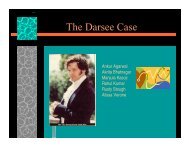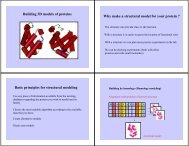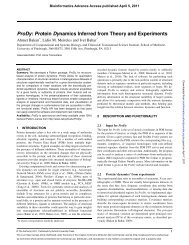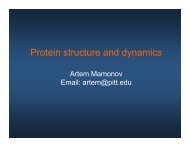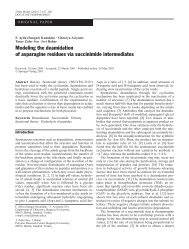Hwang Woo-Suk was a very successful and well-known biomedical ...
Hwang Woo-Suk was a very successful and well-known biomedical ...
Hwang Woo-Suk was a very successful and well-known biomedical ...
Create successful ePaper yourself
Turn your PDF publications into a flip-book with our unique Google optimized e-Paper software.
<strong>Hwang</strong> <strong>Woo</strong>‐<strong>Suk</strong> <strong>was</strong> a <strong>very</strong> <strong>successful</strong> <strong>and</strong> <strong>well</strong>‐<strong>known</strong> <strong>biomedical</strong> scientist who<br />
<strong>was</strong> dismissed in 2006 from Seoul National University in South Korea after<br />
falsely reporting to have succeeded in producing human embryonic stem cells<br />
by cloning, in which two misleading articles were published in the journal<br />
Science.<br />
1
• <strong>Woo</strong>‐<strong>Suk</strong> matriculated at Seoul National University<br />
where he became a veterinarian in his early career.<br />
• After earning his doctorate, he briefly practiced<br />
veterinary medicine, before moving into the field of<br />
<strong>biomedical</strong> research, where he became a full‐time<br />
researcher.<br />
2
• <strong>Woo</strong>‐<strong>Suk</strong> gained media attention after announcing<br />
that he <strong>successful</strong>ly created a cloned cow (Yeongrongi)<br />
in 1999<br />
• Two months later, he reported to have cloned a<br />
Korean cow (Jin‐i)<br />
• <strong>Woo</strong>‐<strong>Suk</strong>’s great accomplishments were recognized<br />
by the Korean media <strong>and</strong> community, which gained<br />
him his heroic title <strong>and</strong> strong supporters.<br />
3
• In February 2004, <strong>Woo</strong>‐<strong>Suk</strong> <strong>and</strong> his colleagues<br />
fraudulently announced, in a published article in<br />
Science, that they have cloned 30 human embryos <strong>and</strong><br />
collected stem cells from one of them.<br />
• This <strong>was</strong> considered a breakthrough in biology as <strong>well</strong><br />
as a great scientific <strong>and</strong> technological advancement in<br />
East Asia.<br />
• In May 2005, <strong>Woo</strong>‐<strong>Suk</strong>’s lab published another<br />
paper, in Science, falsely reporting to have established<br />
11 embryonic stem‐cell lines derived from the skin<br />
cells of individual patients<br />
• Dr. Gerald Schatten of the University of Pittsburgh<br />
co‐authored both papers in which he had not<br />
thoroughly reviewed. 4
• His rise in fame gained him <strong>and</strong> his colleagues:<br />
• International support<br />
• Well‐ funded Laboratories<br />
• Received over $40 million in research funds<br />
• Legislation authorizing human embryos to be cloned for<br />
research<br />
5
• February 12, 04<br />
• L<strong>and</strong> mark paper , on cloning embryos <strong>and</strong> harvesting stem<br />
cells from them<br />
• May , 04<br />
• Question about the source of stem cells arise along with the<br />
possibility of broken bioethics laws in respect to egg<br />
donations<br />
• All calms down<br />
• May 19, 05<br />
• <strong>Hwang</strong>’s team announces creation of 11 embryonic stem cell<br />
lines<br />
7
• November, 05<br />
• Investigation resurfaces<br />
• Gerald Schatten alerts that researcher Sun Il Roh has illegally<br />
traded ova to which Roh later admits<br />
• December, 05<br />
• Univ. of Pittsburgh <strong>and</strong> Univ. of Seoul open investigation<br />
into 2004 <strong>and</strong> 2005 papers<br />
• <strong>Hwang</strong> <strong>and</strong> Shatten asks for retraction of the paper<br />
• Initially 9 of 11 <strong>and</strong> later all stem cell line turn to be fake<br />
8
• January‐February, 06<br />
• Univ. of Seoul states that <strong>Hwang</strong>'s 2004 <strong>and</strong> 2005<br />
papers are based on fraudulent data<br />
• Instead of 400 eggs, 2,221 were used in his research<br />
(Korea's National Bioethics Committee )<br />
• Schatten is cleared of scientific misconduct by the<br />
University of Pittsburgh<br />
9
• May, 06<br />
• <strong>Hwang</strong> charged with:<br />
• embezzling $3 million,<br />
• committing fraud by knowingly using fabricated data to<br />
apply for research funds,<br />
• violating a bioethics law that outlaws the purchase of eggs<br />
for research<br />
• October, 06<br />
• <strong>Hwang</strong> takes the st<strong>and</strong> in court<br />
10
• Egg Donation (Declaration of Helsinki)<br />
• Falsified Data<br />
• Embezzlement <strong>and</strong> Misappropriation of Funding<br />
• Dr. Schatten‐Co‐authoring papers without<br />
verification of results<br />
12
• Egg Donation<br />
• An investigative news program uncovered the facts behind the egg<br />
sc<strong>and</strong>al<br />
• <strong>Hwang</strong> had distributed consent forms to the egg donors, <strong>and</strong> had<br />
driven one woman to the procedure –He originally claimed to have no<br />
knowledge of the offense<br />
• The program had its sponsors withdraw initially because of its<br />
unpatriotic theme<br />
• Falsified Data<br />
• Seoul National University led an investigation with a panel of<br />
scientists who discovered forgery of all 11 “cloned” stem cell lines<br />
(Used DNA Fingerprinting)<br />
13
• Embezzlement of Funds<br />
• Multiple bank accounts in which government funding<br />
<strong>was</strong> present<br />
• Financed a car for his wife with funds<br />
• Co‐Authorship<br />
• <strong>Woo</strong>‐<strong>Suk</strong>’s 2004 paper <strong>was</strong> first rejected, <strong>and</strong> Schatten<br />
fought to get it published even though he had not<br />
verified data (wanted senior co‐author status)<br />
• Schatten succeeded in publishing the fraudulent paper<br />
14
• <strong>Woo</strong>‐<strong>Suk</strong> had become a national hero, which placed<br />
immense pressure on his lab<br />
• Obtained a certain “rock star” status that made him feel<br />
that he could not be touched<br />
• His experiments were difficult to replicate (Very costly)<br />
<strong>and</strong> therefore were tough to verify<br />
15
Consequences <strong>and</strong> Outcomes<br />
16
• <strong>Woo</strong>‐<strong>Suk</strong> is guilty of unlawfully obtaining eggs from<br />
his co‐workers<br />
• However, for the other crimes, <strong>Woo</strong>‐<strong>Suk</strong> holds a story<br />
that would liberate him:<br />
• Spent part of research funds in attempts to clone<br />
extinct Russian mammoths <strong>and</strong> Korean tigers<br />
• Conspiracy against him<br />
• Team members supplied him with false data<br />
• Projects had been sabotaged <strong>and</strong> materials were stolen<br />
17
• South Korean Government<br />
• People of South Korea<br />
• Female coworkers coerced into giving their eggs<br />
• Thous<strong>and</strong>s of Koreans rallied behind <strong>Hwang</strong> after the<br />
egg fiasco<br />
• Many sick <strong>and</strong> elderly got their hopes up for stem cell<br />
treatment<br />
• Scientific community<br />
18
• Scientific papers<br />
• Many papers based on <strong>Woo</strong>‐<strong>Suk</strong>’s false research<br />
• Journal Review<br />
• Tarnished the reputations of many journal editors<br />
• Embryonic stem cell research becomes under scrutiny<br />
• People doubt the possibility of obtaining stem cells<br />
from embryos<br />
19
• Discredited for finding method of obtaining stem cells<br />
from embryos<br />
• Dismissed from Seoul National University<br />
• Indicted on charges of Fraud, Embezzlement, <strong>and</strong><br />
Breach of South Korea’s Bioethics Law<br />
• Title of Supreme Scientist <strong>was</strong> revoked<br />
• Government revoked financial/legal support<br />
• Forced to continue research outside of South Korea<br />
20
• Fired from position as Professor<br />
• University endowed <strong>Woo</strong>‐suk with funding, power, <strong>and</strong> honor.<br />
• <strong>Woo</strong>‐suk embarrassed his university <strong>and</strong> disgraced his coworkers.<br />
• Forced out of South Korea<br />
• Government lent him large sums of money.<br />
• <strong>Woo</strong>‐suk <strong>was</strong> not exiled; he <strong>was</strong> barred from research.<br />
• By leaving, <strong>Woo</strong>‐suk <strong>was</strong> able to avoid many angry countrymen.<br />
• No Physical Detention<br />
• Stripped of dignity<br />
• Eggs, scientific fraud, lied to public<br />
embezzlement<br />
21
• Concerns about Egg Procurement<br />
• Proper documentation of Informed Consent along with<br />
Journal submissions<br />
• Summery or informed consent process<br />
• Institutional Review Board approval forms<br />
• HFEA (Human Fertility <strong>and</strong> Embryology Authority)<br />
Recommendations<br />
• Independent counseling before donating<br />
• Only permitted to donate to research groups unaffiliated with<br />
friends <strong>and</strong> family<br />
• Embezzlement of Government Funds<br />
• Spending oversight committee<br />
Nicholas Wade: It May Look Authentic; Here’s How to Tell It Isn’t. New York Times. Jan 24th, 2006<br />
23
• Falsifying Data<br />
• Adoption of a test to detect photo‐manipulation by<br />
journal editors (The Journal of Cell Biology)<br />
• 25% of accepted manuscripts violate journal guidelines.<br />
1% (14 papers) found fraudulent<br />
• Developing algorithms to spot image manipulation (Hani<br />
Farid, Dartmouth)<br />
• Full‐time reviewers<br />
• Post on server for public feedback prior to<br />
publication<br />
• E‐prints on arXiv.org (Physics, Mathematics, Computer<br />
Science <strong>and</strong> Quantitative Biology)<br />
24
• Emphasizes Importance of the Review Process<br />
• Reduces likelihood of plagiarism<br />
• Highlights Co‐Authorship Responsibilities<br />
• Dr. Gerald Schatten backing <strong>Woo</strong>‐<strong>Suk</strong>’s work<br />
• Evidence that Peer Scrutiny Works<br />
• Scientific community unveiled irregularities in <strong>Hwang</strong>’s<br />
reports<br />
25
• Nicholas Wade: It May Look Authentic; Here’s How<br />
to Tell It Isn’t. New York Times. Jan 24th, 2006<br />
• Philippa Brice: HFEZ favours altruistic egg donation<br />
for cloning research. PHG Foundation News. Feb 16,<br />
2006<br />
• Timeline of Controversy: “A chronology of <strong>Woo</strong> <strong>Suk</strong><br />
<strong>Hwang</strong>'s stem‐cell research,” Nature Magazine. Dec<br />
2005‐Present<br />
26



